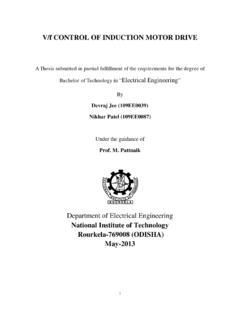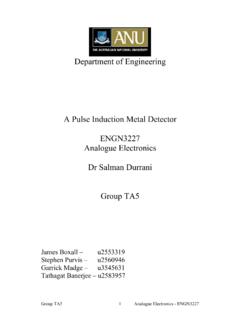Transcription of Types of Electric Motors - UAH - Engineering
1 Types of Electric MotorsElectric MotorsDC MotorsOther MotorshAC MotorsShunt motorSeparately Excited induction motor Stepper motorBrushlessDCmotormotorSeries MotorBrushless DC motorHysteresis motorPermanent Magnet DC (PMDC)Synchronous motorReluctance motorCompounded motorUniversal motorDC Motors11. Shunt DC motor: The rotor and stator windings are connected in Sparately Excited motor: The rotor and stator are each connected from a different power supply, this gives another degree of freedom for controlling the motor over the Series motor: the stator and rotor windings are connected in series. Thus the torque is proportional to I2 so it gives the highest torque per current ratio over all other dc Motors . It is therefore used in starter Motors of cars and elevator Motors (p. 563 Chapman, 4e, 2005 McGrowHill)2005 McGrowHill).4. Permanent Magnet (PMDC) Motors : The stator is a permanent magnet, so the motor is smaller in size.
2 Disadv:onlyusedforlowtorqueapplicationsD isadv: only used for low torque Motors55. Compouned motor: the stator is connected to the rotor through a compound of shunt and series windings, if the shunt and series windings add up together, the motor is called comulatively compounded. If they subtract from each other, then a differentially compounded motor results, which is unsuitable for any application. A: shuntB: seriesC:compoundC: compoundf = field (stator) of DC motors1. Brush wear: Since they need brushes to connect the rotor winding. Brush wear occurs, and it increases dramatically in low pressure environmet. So they cannot be used in artificial hearts. If used on aircraft, the brushes would dltfthftineed replacement after one hour of operation. 2. Sparks from the brushes may cause explosion if the environment contains explosive RF noise from the brushes may interfere with nearby sets, or electronic devices.
3 EtcRef. Chapman p. 674 675AC Machines induction Motor: So called because voltage is induced in the rotor (thus no need for brushes), but for this to happen, therotormustrotateatalowerspeedthanthema gneticthe rotor must rotate at a lower speed than the magnetic field to allow for the existance of an induced voltage. Therefore a new term is needed to describe the induction : the slip. Synchronous Motor: So called because rotor tries to line up with the rotating magnetic field in the stator. It has the statorofaninductionmotor, of an induction motor, and the rotor of a dc cage induction MotorSee it on: : Figure is misleading. The number of poles must beanevenintegerofthenumberofphasesusedbe an even integer of the number of phases used. Thus this diagram should have 6 coils, but that would prevent one from imagining the rotation. AC MachinesAccurate representation of a 6 pole 3 phase AC induction Machines4-17 THREE-PHASE ROTATING FIELDS require three pairs of windings 120 apart energized by voltages that also have a 120windings 120apart, energized by voltages that also have a 120-degree phase displacement.
4 SYNCHRONOUS MOTORSare specifically designed to maintain constant speed with the rotor synchronous to the rotating fieldconstant speed, with the rotor synchronous to the rotating field. Synchronous Motors require modification (such as squirrel-cage windings) to be self-starting. Text and figures on top half of page from Polka Chapter 3 of AC Motors : IEC motors1. Reluctance motor: A synchronous induction motor. The rotor has salient poles and a cage sothatitstartslikeaninductionmotorandso that it starts like an induction motor, and runs like a synchronous Uses soft magnet rotor that is magnetized by the application of current in the stator coilspp3. The magnet is spun by a 3 phase AC motor with no rotor voltage4. The gear teeth are designed to increase the magnetic flux driving the rotor while providing asymmetry that gives it the rotational acceleration5 of the rotor provides a significant increase in inductive power6.
5 Full solution of Faraday s law with time and motors1. Reluctance motor: A synchronous induction motor. The rotor has salient poles and a cage so that it starts like an induction motor, and Brushless DC(actually a ldC,runs like a synchronous Hysteresis motor: hysteresis produces the torque, can be very tiny, used as the driver forelectricclocks(Chapmanp 669) AC motor)for Electric clocks (Chapman, ).3. Stepper motor: a special type of synchronous Motors . Rotates a number of degrees with each Electric DC motor: a close cousin of a permanent magnet stepper motor with electronic controllers5. Universal motor: If a seried dc motor has a htt // l d iki di/ iki di / /6/67laminated stator frame, it can run effectively from an ac supply as well as dc, this is the universla Yourself Question:atthesamepowerWwhichhasaQuestio n: at the same power, Wwhichhas a higher efficiency, the synchronous motor or theinductionmotor?
6 The induction motor? Sol: the synchronous motor, because the lack ofbrushestoconnecttherotoroftheof brushes to connect the rotor of the induction motor makes its magnetic field run throughanairgapwhichhasamuchhigherthroug h an air gap, which has a much higher reluctance.











